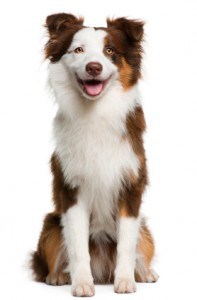Nail trimming is a necessary part of dog ownership. Few Australian Shepherds, especially those who spend the majority of their time indoors or on grass when outdoors, will wear down their nails naturally. If your dog makes an unmistakable click as he walks on hard floors – his nails are too long. Ideally, a dog’s nails should not touch the ground.
This allows a dog to stand squarely and compactly on the pads of his feet. Nails that are too long interfere with a dog’s gait – making walking awkward or painful. Equally important, long nails can be broken, torn off, or snagged, and can scratch furniture, hardwood floors, and skin. Torn or broken nails can cause an Australian Shepherd a great deal of pain and discomfort, and they may become infected, which can require veterinary attention to remove the nails completely.
As with other aspects of grooming, introduce your Aussie to the practice of nail care at a young age. With any luck, the breeder will have started nail clipping as part of the socialization process, as well as to build the puppy’s confidence and teach him to accept having his feet handled.
If you choose to clip the nails yourself, invest in a good quality nail clipper designed specifically for dogs. In the beginning, depending on the puppy’s level of cooperation, you may want to simply touch the nail clipper to the puppy’s nail and then offer plenty of praise. Then progress to clipping tiny bits of nail and then trimming off the remaining dead nail in small bits.
In the early stages, you may need someone to help hold your dog, but once you get used to it, trimming your Australian Shepherd’s nails is no more difficult than trimming your own. When in doubt, ask a veterinarian, groomer, or breeder to show you how to do it properly. Or have a professional trim them regularly, which can mean once a week or once a month – or somewhere in between – depending on the dog.
How To Cut Your Australian Shepherd’s Nails
You will need:
- A high quality nail clipper designed for dogs
- Styptic powder or pencil
Owners are often reluctant to trim their dogs’ nails for fear of hurting the dog or making him bleed. Dogs have a blood vessel that travels approximately three-quarters of the way through the nail. This is called the “quick”. Clipping a dog’s nails too short can cut the quick and cause bleeding. However, learning how to do it properly, using the correct equipment, and having a dog who accepts having his feet handled, will go a long way in reducing the odds of inadvertently nipping the quick.
Your Aussie may have white or black nails or a combination. Black nails can make it difficult to differentiate between the quick and the hook – the dead section of nail that extends beyond the quick.
Examine the underside of the nail before clipping. The section closest to the paw is solid, while the tip – or hook – of the nail looks hollow, like a shell. You may be able to see or feel the slightest groove on the underside hook portion of the nail. Trim only the portion between the solid nail and the thinner hollow part – just tipping it where it curves slightly downward.
One of the easiest ways to trim the nails on the front feet is to have the dog sitting. Lift and hold one foot about 6 inches or so off the ground, so you can see the nail clearly, then trim away. With young or inexperienced dogs, you may have to put the foot back down between nails. Much will depend on the how cooperative the dog is.
With the rear nails, it is easier to have the dog standing. Lift the foot off the ground about 4 to 6 inches, and trim away. Some people find it easier to lift the rear foot and extend the leg backwards, not unlike the position a horse’s leg is in when you are working on his feet. Some people have their dog lie on the floor – this works in a pinch, too. It is really a matter of preference, what is easiest for you, and what the dog will and will not tolerate.
Dewclaws
If your Australian Shepherd has dewclaws, be sure not to overlook them in the trimming process. Dewclaws are the fifth digit on the inside of the front legs, usually an inch or so above the feet. If left unattended, they can curl around and grow into the soft tissue, not unlike an ingrown toenail on a human. Some breeders have the dewclaws removed, so your Australian Shepherd may or may not have them.

